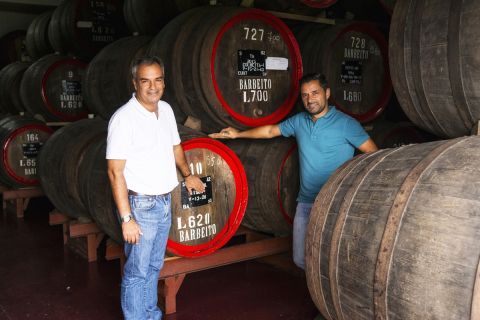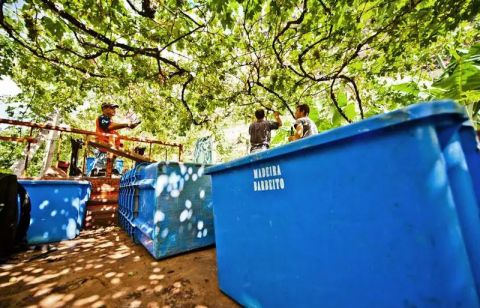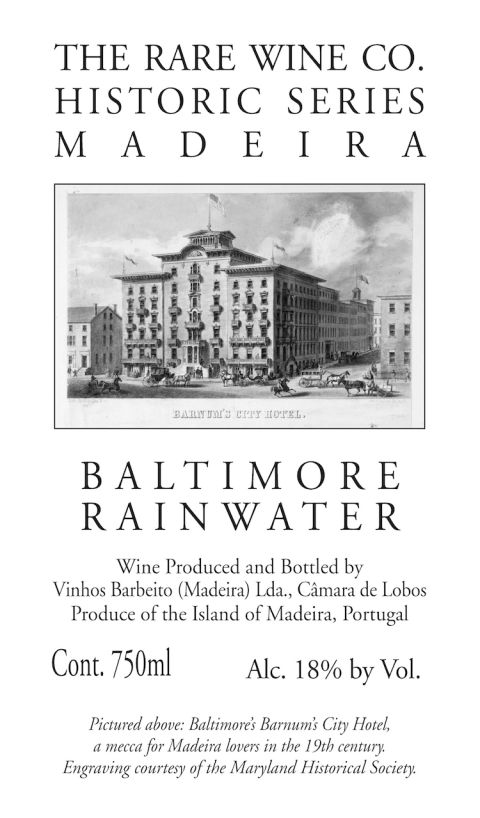Pick some grapes growing on the sheer slopes of a volcanic island in the middle of a vast ocean; ferment the searingly acidic grape juice into searingly acidic wine; choke it with 96% ethanol; cook it; oxidise the hell out of it; stick it in barrels and place it in the hold of a wooden sailing ship; carry it 5,300 km (3,300 miles) across the stormy Atlantic Ocean. Then abandon the barrels on the beach, in heavy rain, for several days. Ta da! Rainwater Madeira.
Of course, that’s tongue in cheek. The term for a fortified wine in Madeira is abafados, which means ‘choked’. Good Madeira is very carefully warmed (not cooked) and very carefully and gently exposed to oxygen (not oxidised to hell and back). And no one really knows the true origins of Rainwater Madeira except that it is a style that the Oxford Companion to Wine (5th edition) defines as ‘a pale, off-dry or medium-dry style of Madeira bottled before it is ten years old and named after wine which was supposedly diluted by rain during shipment to the United States. Still made in small quantities, Rainwater Madeira is defined as being dry to medium dry (1–2.5 °Baumé) with an alcohol level of 18%.’ Jeroen Bronkhorst, author of Madeira Wine Today, describes it as a ‘light style’ of Madeira.
It became a very popular style of Madeira in the US in the early 20th century, even described by Madeira wine connoisseur Douglas H Thomas in 1902 as ‘the highest standard’ of all Madeira. But it fell out of favour as Madeira faced the back-to-back challenges of mildew, phylloxera, Prohibition and two world wars which decimated yields, quality and trade channels, and became synonymous with cheap, diluted, sweetened styles. It took a conversation between Mannie Berk of The Rare Wine Co and Ricardo Diogo Vasconcelos de Freitas of Barbeito for the style to be revived in its classic, elegant 19th-century form.
Barbeito wines, as I wrote in 2021 after a remarkable ‘escape’ to the island during a hair’s-breadth gap between Covid-19 lockdowns, are already made ‘in a style that Richard Mayson characterises as “restrained and delicate [with] a purity and integrity about them”. Ricardo Diogo Freitas, who is in charge, is the only shipper to have completely eschewed the use of caramel as a colouring agent’. Freitas was a history teacher before he came back to rescue the family’s wine business, so perhaps it’s not surprising that it was Freitas, with his reverence for old wines and the island’s historical legacy, who brought this historic style back into modern production.
A Rainwater wine seems somehow fitting for January, in more ways than one. For many of us in the northern hemisphere, it’s a rain-soaked month. For many in the southern hemisphere, it’s the opposite: a prayer-for-rain-soaked month. For those of us in the middle of winter, it’s the glittering brightness of acidity and the tangy warmth of alcohol that we crave after too many too-short days and heavy skies. For those in the heat of summer, it’s the mouth-watering freshness and thirst-quenching energy of the wine.
I’ve chosen two of Barbeito’s Rainwater Madeiras, because he makes them slightly differently for different markets. The US cuvée, The Rare Wine Co Historic Series Baltimore Rainwater, is based on Verdelho (around 80%, blended with 20% Tinta Negra to bring sweetness and depth), medium dry and aged on canteiros without artificial heating for around five years (usually more). The Reserva cuvée sold in the UK and Europe is, conversely, a blend of about 80% Tinta Negra and 20% Verdelho, but it is also medium dry and aged the same way.
Both wines sparkle with spirited vivacity. They are nimble, playful, but very far from simple. They are both energising; they taste and feel like tonic to the soul, body and mind. The Baltimore, made in a style based on 19th-century Rainwaters that Beck tasted in 2008, is named after the city where the style was most adored (so much so that, Berk wrote, ‘the absence of Rainwaters in a 1900 New York auction prompted one merchant to speculate that Baltimore connoisseurs thought so highly of them that they bought them all up and none reached New York.’) It’s more lemony, citrus and silvery to the Reserva’s apples and apricots. The Reserva is tangy with capers and pickled ginger, the Baltimore with tamarind. The Baltimore is a little nuttier, perhaps. The Reserva hints at dried grasses. So, they’re different, but they do the same thing: brighten, lighten and lift.
No fancy food-pairing is needed here, either. In fact, I suggested in my tasting note for the Baltimore that a slice of hot, buttered toast would be a perfect companion. You could add a soft-boiled egg if you were pushing the boat out. They’d both be wonderful with bitter-leaf winter salads (dark-red radicchio, pale-lime Belgian endive, purple cabbage, cavolo nero) dressed with fresh citrus and nuts, or creamy root-veg soups, and thick, bacon-sweet white-bean stews. You could, to be honest, just as easily pair either of them with a steaming bowl of macaroni cheese as you could with a poke bowl.
The Rainwater Reserva is available in at least two dozen independent wine shops in the UK, although the best price by far is the Wine Society at £16 per 50 cl. Mind you, if you’re fast, there is one bottle in stock at Simply Wines Direct, selling for £13.99! Likewise, it’s widely available in Europe. The Baltimore Rainwater is available in more than 15 states in the US, all in standard bottle (75 cl) format – no half measures there, of which I thoroughly approve. An opened bottle, after all, will last far longer than your resistance.
Find the Barbeito Rare Wine Co Baltimore Rainwater Madeira
Find the Barbeito Rainwater Reserva Madeira
The main photo is of my tasting with Freitas at Barbeito in December 2020. The other images come from Barbeito.
For more on Madeira, members can find well over 600 tasting notes in our tasting note database, as well as a rather incredible depth of articles on Madeira – clearly this is a wine we believe deserves more attention than it gets!



















